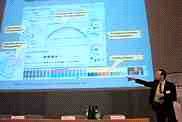Offset Printing
Boosting Efficiency Through Comprehensive Process Control

Friday 07. March 2008 - System Brunner and MAN Roland at Druckforum 2008
Which economic and qualitative benefits can be gained by standardisation in prepress and printing? Which parameters determine quality? And how can these print standards be implemented in daily production? System Brunner and MAN Roland provided the answers at Druckforum 2008.
Declining run lengths are forcing printing companies to produce more and more jobs in less and less time. This is the only way they can remain profitable and competitive. An important element here is standardisation in prepress and printing and how this is accomplished was explained by System Brunner and MAN Roland at Druckforum 2008 in Stuttgart. »Boosting efficiency through comprehensive process control« was the title of the presentation made by these big names in the industry.
Comprehensive process control – what does that mean?
Sophisticated and extremely precise measuring and regulating systems ensure comprehensive control of the printing process. The measured data is portrayed in an easily understandable manner and indicates any disturbances in the printing process. Comprehensive process standardisation saves costs not only at the press but along the entire production chain which has four segments: job acquisition, job handling, prepress, and post-press operations/logistics. Standardisation through the use of color control systems at the press is a first step in tapping potential savings in job acquisition and printing. Fast makereadies and stable print quality make print production more efficient which results in fewer complaints and greater process security and this makes job acquisition much easier.
There are many different factors that can lead to costly errors in print production. In prepress these may be proofing problems caused by incorrect image data editing or a wrongly loaded ICC profile, but more often the simulation of a standardised offset print is not identical with the desired result which reduces the efficiency of print production considerably. Plate-making can also be the cause of poor print quality if unsuitable consumable materials are used and the exposure and development processes are unstable. How can one avoid such problems?
The remedies
System Brunner presented practical tools for process control and standardisation. The Print Expert Suite contains solutions for all aspects of production: Proof Checker, Plate Checker and Print Curve Checker ensure sustained production quality. The data gained can be stored in a central data pool where it can be decentrally accessed. This enables production to be monitored and analysed regarding quality- and process-relevant parameters. Interfaces to an MIS and presses are available.
Gray balance: “The Soul of the Picture”
The main reason why System Brunner and its users are so successful can be found in the System Brunner standardisation concept. Regardless of the user, the companys products can optimise and, especially, automate the printing process right down to the smallest detail. The tight tolerances prescribed by EUROSTANDARD/GLOBAL-
STANDARD are contained in every module, enabling in all cases standardised and efficient printing production in the highest “Swiss” quality. The central element of System Brunners standardisation concept and the design of its modules is gray balance which, along with control of tone value increases and solid ink densities, has the highest priority. The PRINT EXPERT* Suite, okBalance* and INSTRUMENT FLIGHT* technologies play an important part in this.
Communication as a success factor
Efficient communication within a printing company is an important success factor. This increases production flexibility and reliability and has a positive effect on communication with customers as well. Which is why many companies have their Quality Management systems certified but this only reflects the momentary situation and so it is important that it is continually reviewed and practised in all areas. When this is done, standardisation of processes and production provide economic growth.
